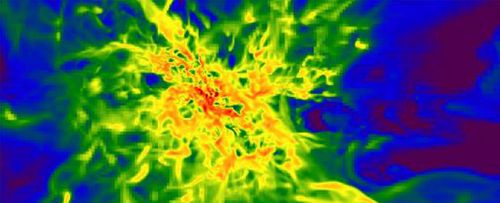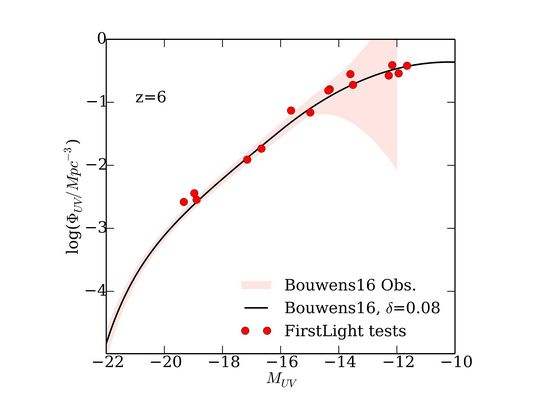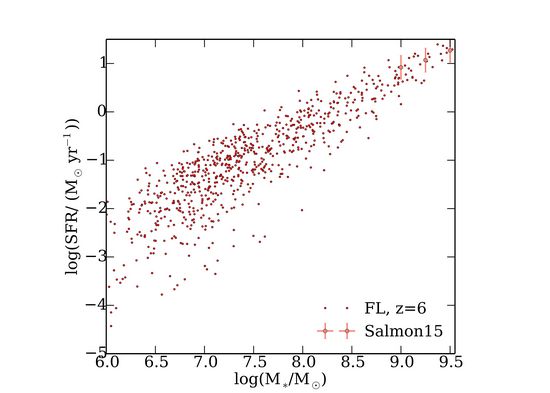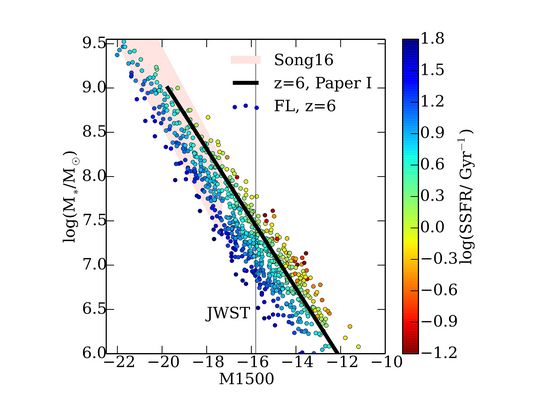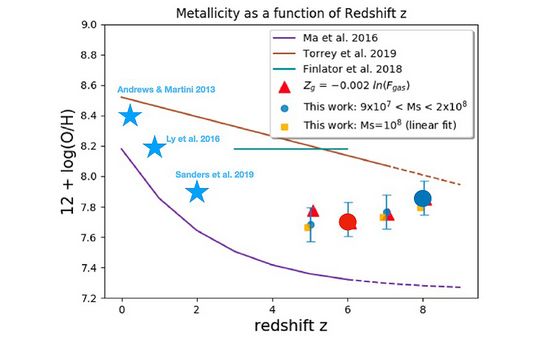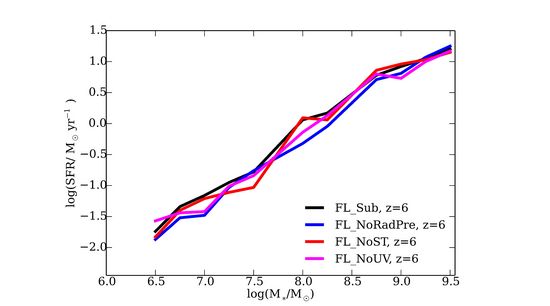ASTROPHYSICS
FirstLight: Formation of the First Galaxies at Cosmic Dawn
Principal Investigator:
Daniel Ceverino
Affiliation:
Zentrum für Astronomie, Institut für Theoretische Astrophysik, Universität Heidelberg
Local Project ID:
pr92za
HPC Platform used:
SuperMUC and SuperMUC-NG of LRZ
Date published:
Introduction
The formation of the first galaxies is one of the key milestones in the history of the Universe. When the Universe was only 380 thousand years old, it was mostly neutral and cold. These Dark Ages finished by the formation of the first galaxies. They started to ionize Hydrogen approximately 400 Million years after the Big Bang. The Epoch of Reionization has been a subject of considerable interest in the last decades. However, very little is known about the properties of these first galaxies. The deepest observations with the Hubble Space Telescope have yielded a handful of tiny and faint objects.
The launch of the James Webb Space Telescope (JWST) will completely revolutionize our understanding of Universe Reionization. One of the four main Science Themes for JWST is to unveil the properties of first galaxies (http://jwst.nasa.gov/firstlight.html). JWST will yield very deep surveys of galaxies at extremely high redshifts (z>5). This will provide unprecedented details about the first galaxies and it will generate considerable public interest. As quoted in the above link, “Webb will be a powerful time machine with infrared vision that will peer back over 13.5 billion years to see the first stars and galaxies forming out of the darkness of the early universe”.
This is a crucial time for theoretical predictions about the properties of the first galaxies. They are needed for the design of successful observations and to interpret the first results from JWST. Semi-empirical methods and large cosmological simulations have provided predictions of the abundances of these galaxies but they lack the details about the distribution of gas, stars, metals and dust within first galaxies. This is a crucial aspect. For example, the distribution of these components affects the overall ability of ionizing photons to escape these galaxies and ionize the Universe.
There are two main approaches in cosmological simulations of galaxy formation. The first approach uses a full cosmological box. These simulations yield a large population of galaxies but their interiors are poorly resolved. The second approach uses zoom-in simulations that concentrate the computational resources on the formation and evolution of a few selected galaxies. However previous sets of zoom-in simulations were small, with only a dozen of independent galaxies. The FirstLight project has generated a sample of over 1000 zoom-in cosmological simulations of the first galaxies. The full exploitation of this dataset will allow us to infer global properties of the galaxy population while resolving the galaxy interiors with parsecs resolution. A first data release is available to the community at the project website and it will motivate many interesting projects in the coming years.
Methods
The simulations are performed using the ART code, which accurately follows the evolution of a gravitating N-body system and the Eulerian gas dynamics using an Adaptive Mesh Refinement (AMR) approach. ART is a hybrid MPI+OpenMP code that uses domain decomposition of the whole cosmological volume. Each MPI task makes refinement of the grid around a distinct lagrangian region where a single galaxy forms and evolves. This decomposition minimizes the communication between tasks, because they only share the base grid. The parallelization within a node is done using OpenMP. No external libraries are required. The full project uses 1000 MPI tasks, distributed over 1000 nodes (28k cores). It needs approximately 2Gb of memory per core for the most expensive tasks. Therefore, the maximum memory required will be 5Tb. The MPI tasks are approximately distributed in 10 independent runs. Each one uses about 100 Haswell nodes of LRZ HPC system SuperMUC. 20M CPU hours were consumed. 0.5M files were generated and temporarily stored in PROJECT (15 Tb of storage).
Main Results:
Paper I has yielded UV luminosity function (UVLF), galaxy stellar mass function, stellar-mass-halo-mass and other scaling relations at redshift z=6-10 in good agreement with existing observations, when available. The simulations predict a flattening of the UVLF at magnitudes fainter than MUV=-14 due to stellar feedback. They also predict a rapid evolution of the faint slope of the UVLF and this implies a large number of galaxies with moderately faint luminosities during the dark ages (z=10). These predictions will be tested by JWST.
Allowed by the large number statistics, Paper II focuses on the mean galaxy properties (stellar mass, gas mass, and SFR) over a large range of halo masses. It unveils the physical origin of the star-forming main sequence (SFMS) during the early galaxy assembly (z=5-15). Its evolution is governed by the expansion of the Universe and by the accretion of gas from the cosmic web. The scatter of the sequence is correlated with the gas fraction and the efficiency in converting gas into stars.
Paper III introduces the first steps in the build-up of a mock galaxy catalog: the generation of the intrinsic, dust-free, spectral energy distribution, including stellar light, nebular emission lines and continuum. It makes predictions of the rest-frame, UV absolute magnitude (M1500) and identifies the specific SFR as the driver of the scatter in the stellar mass-UV magnitude relation.
The next step in the generation of the mock galaxy catalog is the inclusion of dust, but first a master student at the Cosmic Dawn Center (DAWN) has checked that the mass-metallicity relation in the FirstLight galaxies is roughly consistent with the findings in other simulations and observations. As opposed to some models, the mass metallicity relation in FirstLight evolves very little at cosmic dawn (z=5-8). Over this interval, the metallicity of FirstLight galaxies at a fixed stellar mass declines by ≤ 0.2 dex. This contrasts with the observed tendency for metallicities to increase at lower redshifts, and reflects weakly-evolving or even increasing gas fractions at the Reionization Epoch.
Feedback remains as the biggest uncertainty in galaxy formation. Therefore, the sensitivity of these results to different models of feedback has been tested by rerunning a subset of the simulations with different models of feedback. Instead of using a single zoom-in simulation with different feedback models, a large subsample of 55 zoom-in simulations was used. This allows to disentangle the effects of feedback on the population-averaged properties at different galaxy scales. The averaged SFR hardly change within a factor 2 for the same stellar mass and redshift. This is much lower than the intrinsic scatter of this relation, shown above.
More analysis is underway and it will help to distinguish between different models of feedback and constrain new mechanisms.
Research Team:
Daniel Ceverino (PI)1, Ralf Klessen1, Simon Glover1
1 Zentrum für Astronomie der Universität Heidelberg, Institut für Theoretische Astrophysik, Heidelberg, Germany
Link:
http://www.ita.uni-heidelberg.de/~ceverino/FirstLight/index.html
Project publications:
- “Introducing the FirstLight project: UV luminosity function and scaling relations of primeval galaxies”. Ceverino, D; Glover, S. C. O.; Klessen, R. S., MNRAS, 470, 2791 (2017).
- “FirstLight II: Star formation rates of primeval galaxies from z=5-15”. Ceverino, D., Klessen, R. S., & Glover, S. C. O., MNRAS, 480, 4842 (2018).
- “FirstLight III: rest-frame UV-optical spectral energy distributions of simulated galaxies at cosmic dawn”. Ceverino, D., Klessen, R. S., & Glover, S. C. O., MNRAS, 484, 1366 (2019).
- “Weak evolution of the mass-metallicity relation at cosmic dawn in the FirstLight simulations”. Langan, I., Ceverino, D., & Finlator, K., MNRAS, 494, 1988 (2020).
Scientific Contact
Dr. Daniel Ceverino
Zentrum für Astronomie der Universität Heidelberg (ZAH)
Albert-Ueberle-Str. 2, D-69120 Heidelberg (Germany)
e-mail: ceverino [@] uni-heidelberg.de
Local project ID: pr92za
October 2020

